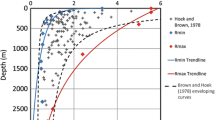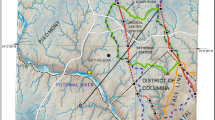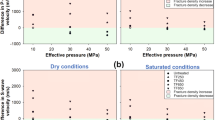Abstract
Permeability loss with depth is a general trend in geological media and plays an essential role in subsurface fluid flow and solute transport. In the near surface zone where groundwater movement is active, the decrease in permeability with depth is dominated by the mechanical compaction of deformable media caused by the increase in lithostatic stress with depth. Instead of using empirical equations from statistical analysis, by considering the well-defined relationships among permeability, porosity, fracture aperture and effective stress under lithostatic conditions, new semi-empirical equations for the systematic depth-dependent permeability are derived, as well as the equations for the depth-dependent porosity in a porous medium and the depth-dependent fracture aperture in a fractured medium. The existing empirical equations can be included in the new equations as special cases under some simplification. These new semi-empirical equations perform better than previous equations to interpret the depth-dependent permeability of the Pierre Shale (with a maximum depth of approximately 4,500 m) and the granite at Stripa, Sweden (with a maximum depth of about 2,500 m).
Résumé
La perte de perméabilité avec la profondeur est une tendance générale dans le milieu géologique et joue un rôle essentiel sur le flux de subsurface et le transport de soluté. Dans la zone d’écoulement de nappe proche de la surface, la diminution de perméabilité avec la profondeur est contrôlée par la compaction mécanique d’un milieu déformable causée par l’accroissement de la pression de couverture avec la profondeur. Au lieu d’utiliser des équations empiriques tirées de l’analyse statistique, en considérant les relations bien définies entre perméabilité, porosité, ouverture des fractures et pression, on a établi de nouvelles équations semi-empiriques corrélant, avec la profondeur, perméabilité, porosité d’un milieu poreux, ouverture de la fracturation d’un milieu fracturé. Les équations empiriques existantes peuvent être comprises dans les nouvelles équations en tant que cas particuliers à condition de quelque peu simplifier. Ces nouvelles équations semi-empiriques rendent, mieux que les équations précédentes, compte de la perméabilité en fonction de la profondeur à Pierre Shale (à une profondeur maximale d’environ 4,500 m) et dans le granite de Stripa, Suède (à une profondeur maximale d’environ 2,500 m).
Resumen
La pérdida de la permeabilidad con la profundidad es una tendencia general en los medios geológicos y juega un rol esencial en el flujo de fluidos subsuperficiales y transporte de solutos. En la zona cercana a la superficie donde el movimiento del agua subterránea es activo, la disminución de la permeabilidad con la profundidad está dominada por la compactación mecánica del medio deformable provocado por el incremento de la presión litostática con la profundidad. En lugar de usar ecuaciones empíricas del análisis estadístico se desarrollaron nuevas ecuaciones semiempíricas para dependencia sistemática de la profundidad considerando las relaciones definidas de los pozos entre permeabilidad, porosidad, apertura de las fracturas y presión efectiva bajo condiciones litostáticas, así como también las ecuaciones para la dependencia con la profundidad de la porosidad de un medio poroso y dependencia de la apertura de la fractura con la profundidad de un medio fracturado. Las ecuaciones empíricas existentes pueden ser incluidas en las nuevas ecuaciones como casos especiales bajo alguna simplificación. Estas nuevas ecuaciones semiempíricas son más adecuadas que las ecuaciones previas en la interpretación de la dependencia de la permeabilidad con la profundidad de Pierre Shale (con una profundidad máxima de aproximadamente de 4,500 m) y el granito en Stripa, Suecia (con una profundidad máxima de alrededor de 2,500 m).
摘 要
渗透性随埋深减小是地质介质的普遍规律, 对地下流体运动和溶质运移具有重要影响. 在地下水很活跃表层区, 渗透性随深度衰减的趋势主要取决于地层压力增加引起的介质压缩变形. 与基于统计分析得到经验公式不同, 本文考虑渗透率, 孔隙度, 裂隙张开度和有效应力在自重应力条件下的明确相互关系, 推导了半经验半理论式的渗透率-埋深趋势方程, 并且得到了孔隙介质的孔隙度和裂隙介质的隙宽随埋深变化的公式. 现有的经验公式可以作为本文新公式的某些简化特例. 在解释Pierre页岩(最大深度达4,500 m)和瑞典Stripa场地花岗岩 (最大深度达2,500 m) 渗透率-埋深特征方面, 新的半经验公式比过去的公式更有效.
Resumo
A perda de permeabilidade com a profundidade é uma tendência geral nos meios geológicos e desempenha um papel essencial no escoamento de fluidos e no transporte de soluto na subsuperfície. Na zona próxima da superfície, onde o movimento das águas subterrâneas está activo, a diminuição da permeabilidade com a profundidade é dominada pela compactação mecânica do meio deformável causada pelo aumento da pressão litostática com a profundidade. Em vez de se utilizarem equações empíricas provenientes da análise estatística, considerando as bem definidas relações entre permeabilidade, porosidade, abertura das fracturas e pressão efectiva sob condições litostáticas, derivam-se novas equações semi-empíricas para a sistemática permeabilidade dependente da profundidade, assim como equações para a porosidade dependente da profundidade num meio poroso e para as aberturas das fracturas dependentes da profundidade num meio fracturado. Fazendo algumas simplificações, as equações empíricas existentes podem ser incluídas nas novas equações, como casos especiais. Estas novas equações semi-empíricas resultam melhor do que as anteriores equações na interpretação da permeabilidade dependente da profundidade dos Xistos de Pierre (com uma profundidade máxima de aproximadamente 4,500 m) e do granito de Stripa, Suécia (com uma profundidade máxima de cerca de 2,500 m).





Similar content being viewed by others
References
Amthor JE, Mountjoy EW, Machel HG (1994) Regional-scale porosity and permeability variations in Upper Devonian Leduc buildups: implications for reservoir development and prediction in carbonates. AAPG Bull 78:1541–1559
Anderman ER, Hill MC (2003) MODFLOW-2000, the U.S. Geological Survey modular ground-water model—three additions to the hydrogeologic-unit flow (HUF) package: alternative storage for the uppermost active cells (SYTP parameter type), flows in hydrogeologic units, and the hydraulic-conductivity depth-dependence (KDEP) capability. US Geol Surv Open-File Rep 03-347
Athy LF (1930) Density, porosity and compaction of sedimentary rocks. AAPG Bull 14:1–22
Bandis S, Lumsden AC, Barton NR (1983) Fundamentals of rock joint deformation. Int J Rock Mech Min Sci Geomech Abstr 20:249–268
Barton CA, Zoback MD, Moos D (1995) Fluid flow along potentially active faults in crystalline rock. Geology 23:683–686
Beall AO, Fisher AG (1969) Sedimentology. Initial Rep Deep Sea Drilling Project 1:521–593
Bear J (1972) Dynamics of fluids in porous media. Elsevier, New York
Belitz K, Bredehoeft JD (1988) Hydrodynamics of the Denver basin: explanation of subnormal fluid pressure. AAPG Bull 72:1334–1359
Bernabe Y, Mok U, Evans B (2003) Permeability-porosity relationships in rocks subjected to various evolution processes. Pure Appl Geophys 160:937–960
Bethke CM, Corbit TF (1988) Linear and nonlinear solutions for one-dimensional compaction flow in sedimentary basins. Water Resour Res 24:461–467
Bloch S, Suchecki RK, Duncan JR, Bjorlykke K (1986) Porosity prediction in quartz-rich sandstones: Middle Jurassic, Haltenbanken area, offshore central Norway. AAPG Bull Abstr 70:567
Budd DA (2001) Permeability loss with depth in the Cenozoic carbonate platform of west-central Florida. AAPG Bull 85:1253–1272
Carlsson H, Carlsson L, Jamtlid A, Nordlander H, Olsson O, Olsson T (1983) Cross-hole techniques in a deep seated rock mass. Bull Int Assoc Eng Geol 26–27:377–384
Civan F (2000) Reservoir formation damage: fundamentals, modeling, assessment, and mitigation. Gulf, Houston, TX
Civan F (2001) Scale effect on porosity and permeability: kinetics, model, and correlation. AIChE J 47(2):271–287
Connolly JAD, Podladchikov YY (2000) Temperature-dependent viscoelastic compaction and compartmentalization in sedimentary basins. Tectonophysics 324:137–168
David C, Wong TF, Zhu W, Zhang J (1994) Laboratory measurement of compaction-induced permeability change in porous rocks: implications for the generation and maintenance of pore pressure excess in the crust. PAGEOPH 143:425–456
Davis JP, Davis DK (1999) Stress-dependent permeability: characterization and modeling. SPE paper No. 56813, Society of Petroleum Engineers, Richardson, TX
Domenico PA, Schwartz FW (1998) Physical and chemical hydrogeology, 2nd edn. Wiley, New York
Dunnington HV (1967) Aspects of diagenesis and shape change in stylolitic limestone reservoirs. In: Proc. 7th World Petroleum Congr., Mexico City, April 1967, vol 2, pp 339–352
Ehrenberg SN, Nadeau PH (2005) Sandstone vs. carbonate petroleum reservoirs: a global perspective on porosity-depth and porosity-permeability relationships. AAPG Bull 89:435–445
Fuchtbauer H (1967) Influence of different types of diagenesis on sandstone porosity. In: Proc. 7th World Petroleum Congr., Mexico City, April 1967, vol 2, pp 353–369
Gallichand J (1994) Numerical simulations of steady-state subsurface drainage with vertically decreasing hydraulic conductivity. Irrig Drain Syst 8:1–12
Ghabezloo S, Sulem J, Saint-Marc J (2009) Evaluation of a permeability–porosity relationship in a low-permeability creeping material using a single transient test. Int J Rock Mech Min Sci 46:761–768
Hart DJ, Hammon III WS (2002) Measurement of hydraulic conductivity and specific storage using the shipboard Manheim squeezer. In: Salisbury MH, Shinohara M, Richter C, et al (eds) Proceedings of the Ocean Drilling Program, 2002, Initial Reports vol 195, chap 6, Ocean Drilling Program, College Station, TX
Hoek E, Brown ET (1980) Underground excavations in rock. Institution of Mining and Metallurgy, London
Jiang XW, Wan L, Wang XS, Liang SH, Bill H (2009a) Estimation of fracture normal stiffness using a transmissivity-depth correlation. Int J Rock Mech Min Sci 46:51–58
Jiang XW, Wan L, Wang XS, Wu X, Zhang X (2009b) Estimation of rock mass deformation modulus using variations in transmissivity and RQD with depth. Int J Rock Mech Min Sci 46(8):1370–1377. doi:10.1016/j.ijrmms.2009.05.004
Jiao JJ, Zheng C (1998) Abnormal fluid pressures caused by deposition and erosion of sedimentary basins. J Hydrol 204:124–137
Liu HH, Rutqvist J, Berryman JG (2009) On the relationship between stress and elastic strain for porous and fractured rock. Int J Rock Mech Min Sci 46:289–296
Louis C (1974) Rock hydraulics. In: Muller L (ed) Rock mechanics. Springer, Vienna, pp 299–387
Lucia FJ (1995) Rock-fabric/petrophysical classification of carbonate pore space for reservoir characterization. AAPG Bull 79(9):1275–1300
Luo X, Vasseur G (1992) Contributions of compaction and aquathermal pressuring to geopressure and the influence of environmental conditions. AAPG Bull 76:1550–1559
Manning CE, Ingebritsen SE (1999) Permeability of the continental crust implications of geothermal data and metamorphic systems. Rev Geophys 37:127–150
Marklund L, Wörman A (2007) The impact of hydraulic conductivity on topography driven groundwater flow. Publs Inst Geophys Pol Acad Sc E-7:159–167
Martin CD, Christiansson R (2009) Comparison of the minimum horizontal stress from overcoring and hydraulic fracturing at Forsmark, Sweden. Proceedings of SINOROCK 2009, Hongkong, May 2009
Min KB, Rutqvist J, Tsang C-F, Jing L (2004) Stress-dependent permeability of fractured rock masses: a numerical study. Int J Rock Mech Min Sci 41:1191–1210
Nagumo S (1965) Compaction of sedimentary rocks: a consideration by the theory of porous media. Bull Earthq Res Inst 43:339–348
Neuzil CE (1986) Groundwater flow in low-permeability environments. Water Resour Res 22:1163–1195
Neuzil CE (1993) Low fluid pressure within the Pierre Shale: a transient response to erosion. Water Resour Res 29:2007–2020
Neuzil CE (2003) Hydromechanical coupling in geologic processes. Hydrogeol J 11:41–83
Oda M (1986) An equivalent continuum model for coupled stress and fluid flow analysis in jointed rock masses. Water Resour Res 22:1845–1856
Olsson R, Barton N (2001) An improved model for hydromechanical coupling during shearing of rock joints. Int J Rock Mech Min Sci 38:317–329
Ramm M (1992) Porosity-depth trends in reservoir sandstones: theoretical models related to Jurassic sandstones offshore Norway. Mar Petrol Geol 9:553–567
Raven KG, Gale JE (1985) Water flow in a natural rock fracture as a function of stress and sample size. Int J Rock Mech Min Sci Geomech 22:251–261
Rice JR (1992) Fault stress states, pore pressure distributions and the weakness of the San Andreas fault. In: Evans B, Wong T-F (eds) Fault mechanics and transport properties of rocks. Academic Press. Ltd., San Diego, CA, pp 475–504
Rubey WW, Hubbert MK (1959) Role of fluid pressure in mechanics of overthrust faulting: II. overthrust belt in geosynclinal area of western Wyoming in light of fluid-pressure hypothesis. Geol Soc Am Bull 70:167–206
Rushton KR, Chan YK (1976) Pumping test analysis when parameters vary with depth. Ground Water 14:82–87
Rutqvist J, Stephansson O (2003) The role of hydromechanical coupling in fractured rock engineering. Hydrogeol J 11:7–40
Rutqvist J, Wu Y-S, Tsang C-F, Bodvarsson G (2002) A modeling approach for analysis of coupled multiphase fluid flow, heat transfer, and deformation in fractured porous rock. Int J Rock Mech Min Sci 39:429–442
Saar MO, Manga M (2004) Depth dependence of permeability in the Oregon Cascades inferred from hydrogeologic, thermal, seismic, and magmatic modeling constraints. J Geophys Res 109:B01204
Schmidt V, McDonald DA (1979) The role of secondary porosity in the course of sandstone diagenesis. In: Scholle PA, Schluger PR (eds) Aspects of Diagenesis. SEPM Spec Publ 26:175–207
Schneider F, Potdevin JL, Wolf S, Faille I (1996) Mechanical and chemical compaction model for sedimentary basin simulators. Tectonophysics 263:307–317
Snow DT (1968a) Rock fracture spacings, openings, and porosities. J Soil Mech Found Div ASCE 96:73–91
Snow DT (1968b) Hydraulic character of fractured metamorphic rocks of the Front Range and implications of the Rocky Mountain arsenal well. Colo Sch Mines Q 63:167–199
Tsang YW, Witherspoon PA (1981) Hydromechanical behavior of a deformable rock fracture subject to normal stress. J Geophys Res 86:9287–9298
Turcotte DL, Schubert G (2001) Geodynamics, 2nd edn. Cambridge University Press, Cambridge, UK
Walder J, Nur A (1984) Porosity reduction and crustal pore pressure development. J Geophys Res 89:11539–11548
Walsh JB, Brace WF (1984) The effect of pressure on porosity and the transport properties of rock. J Geophys Res 89:9425–9431
Wang XS, Jiang XW, Wan L, Song G, Xia Q (2009) Evaluation of depth-dependent porosity and bulk modulus of a shear using permeability–depth trends. Int J Rock Mech Mining Sci 46(7):1175−1181. doi:10.1016/j.ijrmms.2009.02.002
Wei ZQ, Egger P, Descoeudres F (1995) Permeability predictions for jointed rock masses. Int J Rock Mech Min Sci Geomech Abstr 32:251–261
Whittemore DO, Macfarlane PA, Doveton, JH, Butler JAJ, Chu TM, Bassler R, Smith M, Mitchell J, Wade A (1993) The Dakota aquifer Program annual report, FY92, KGS Open-File Rep 93–1, Kansas Geological Survey, Lawrence, KS
Witherspoon PA, Wang JSY, Iwai K, Gale JE (1980) Validity of cubic law for fluid flow in a deformable rock fracture. Water Resour Res 16:1016–1024
Wong TF, Ko SC, Olgaard DL (1997) Generation and maintenance of pore pressure excess in a dehydrating system 2. Theoretical analysis. J Geophys Res 102:841–852
Zhang L, Franklin JA (1993) Prediction of water flow into rock tunnels: an analytical solution assuming a hydraulic conductivity gradient. Int J Rock Mech Min Sci Geomech Abstr 30:37–46
Zhao J (1998) Rock mass hydraulic conductivity of the Bukit Timah granite, Singapore. Eng Geol 50:211–216
Zhu W, David C, Wong TF (1995) Network modeling of permeability evolution during cementation and hot isostatic pressing. J Geophys Res 100:15451–15464
Zimmerman RW, Somerton WH, King MS (1986) Compressibility of porous rocks. J Geophys Res 91:12765–12777
Acknowledgements
This research is financially supported by the Yalongjiang River Joint Fund established by the National Natural Science Foundation of China and the Ertan Hydropower Development Company (Grant No. 50639090). The research is also partially supported by the Program of Outstanding Overseas Chinese Young Scholars established by the National Natural Science Foundation of China (Grant No. 40528003). We appreciate valuable comments from Dr. D. Hart and two anonymous reviewers as well as constructive suggestions from the editors, Dr. J. Bahr and Dr. J. Jiao.
Author information
Authors and Affiliations
Corresponding author
Rights and permissions
About this article
Cite this article
Jiang, XW., Wang, XS. & Wan, L. Semi-empirical equations for the systematic decrease in permeability with depth in porous and fractured media. Hydrogeol J 18, 839–850 (2010). https://doi.org/10.1007/s10040-010-0575-3
Received:
Accepted:
Published:
Issue Date:
DOI: https://doi.org/10.1007/s10040-010-0575-3




